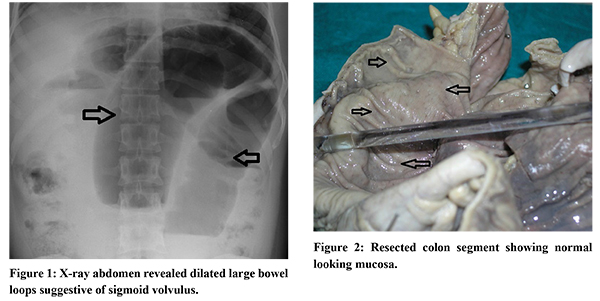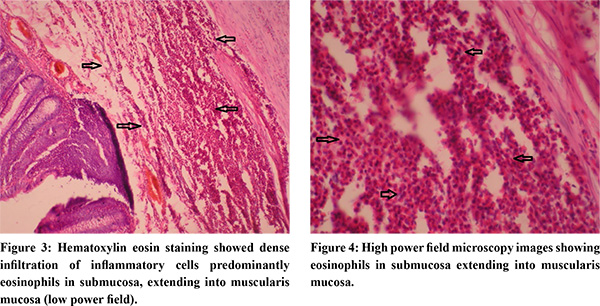A young man presented with acute onset abdominal pain. His radiograph showed sigmoid volvulus, confirmed the same with CT abdomen. As the patient had recurrent similar episodes in past, sigmoidectomy plus end-to-end anastomosis was done. Intraoperative colonoscopy showed no significant luminal pathology but histopathology examination of resected bowel was suggestive of eosinophilic colitis (EC). Colon involvement in eosinophilic gastrointestinal disease is quite rare and manifestation of sigmoid volvulus is very rare.
Case Report
A 24-year-old young man presented with complaints of acute onset abdominal distension and pain abdomen. He had similar episodes three to four times in last 6 months and was treated conservatively. X-Ray abdomen revealed dilated large bowel loops suggestive of sigmoid volvulus (Figure 1). After sigmoidoscopic decompression of c-olon, computerized tomography of abdomen was done, suggestive of dilated large bowel loops. His hematological and biochemical parameters were within normal limits. Patient underwent laparotomy and sigmoidectomy plus end-to-end anastomosis. Intra-operative colonoscopy was done which showed no significant mucosal pathology. Resected surgical specimen (Figure 2) was sent for histopathology examination. Hematoxylin &eosin staining showed dense infiltration of inflammatory cells predominantly eosinophils in submucosa, extending into muscularis mucosa (Figure 3 and 4). No features suggestive of inflammatory bowel disease, parasitic infection or other infective causes were identified, hence diagnosed as eosinophilic colitis (EC). Post operatively, he recovered well. He was given prednisolone (20 mg/day) for two weeks during post operative course and was suggested to start on six-food elimination diet (i.e., wheat, milk, soy, egg, nuts, fish and shellfish). He never had symptom recurrence during post operative follow up (one year).


Discussion
EC is a rare manifestation in contrast to the increasingly recognized eosinophilic esophagitis and enteritis1 and presentation as sigmoid volvulus is unusual2. Six-food elimination diet and short duration steroid are the first line modalities for treating eosinophilic gastrointestinal diseases. However, other immunosuppressive agents may be required in patients in whom EC relapses during or after drug tapering3.
References
- Alfadda A, Storr M, Shaffer E. Eosinophilic colitis: Epidemiology, clinical features, and current management. Ther Adv Gastroenterol. 2010;4(5):301–9.
- Zucker K, Pradhan F, Gomez A, Nanda R. Eosinophilic Colitis in Recurrent Sigmoid Volvulus. ACG Case Rep J. 2021 Aug 25;8(8):e00650.
- Giudici G, Ribaldone DG, Astegiano M, Saracco GM, Pellicano R. Eosinophilic colitis: clinical review and 2020 update. Minerva Gastroenterol Dietol. 2020 Jun;66(2):157-163.